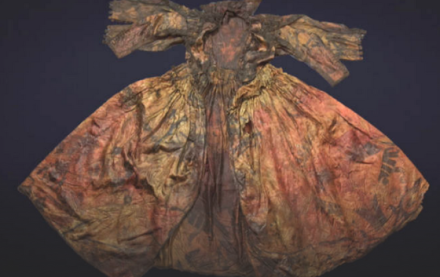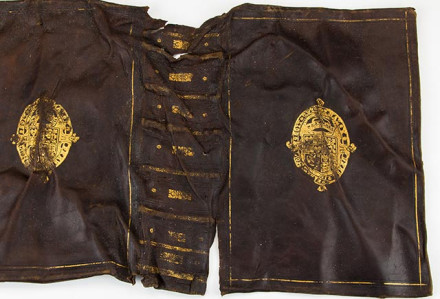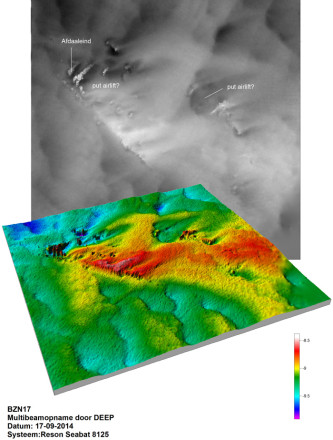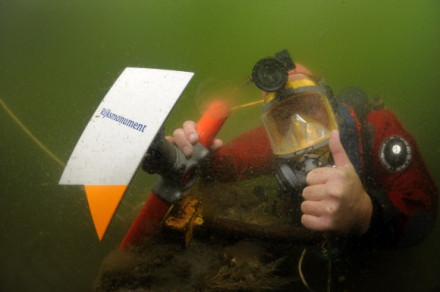History
In 2009, a wreck was found on the old roadsteads of the island of Texel (the Netherlands). It was called Burgzand Noord 17 (BZN 17) after its location and it was discovered by recreational divers of the Texel diving club. It turned out to be a very well conserved wreck with many artefacts in a very good condition. On of the most remarkable finds was a dress (see below), which generated a lot of media attention. The ship is also known as the Palmhoutwrak ('Boxwood wreck') because a large part of the cargo consisted of this material. The good condition of many parts of the cargo and the interesting combination of finds received much attention in the media and much research was done into which ship it concerns - which has not been established yet.
Description
BZN 17 is the wreck of a Dutch-built armed merchantman (a straatvaarder, pinas or flute) that was likely built around 1640-1650. The original name is unknown. The ship is well preserved to the uppermost main deck. Most of the ship and hull seem to be well preserved in the sand. Site dimensions are ca. 40 x 20 m. At least five cannons were reportedly salvaged. One cannon is from this wreck has been officially reported. The other four have disappeared/have been illegally salvaged.
Date
Dendrochronological analysis of the planking and part of a frame has given a clear date.
- Sample BZS00071 date 1630 AD (with a margin of 8 years).
- Sample BZN00051 felled in 1638 AD (with a margin of 9 years).
This way of dating shows the period in which the wood that was used in the construction of the ship was cut and thus gives us a so-called terminus post quem, a date after which the ship was built (DCCD report no. P:2016001).
Origin
Construction features make it probable that it was a Dutch-built ship. The provenance of the wood was Lower Saxony in Germany. These dates fit the inscription on a Jacob's staff that was found on the wreck, which has the year 1636 on it. One cannon, reportedly salvaged from the wreck by recreational divers, has an inscription of the Admiralty of Amsterdam indicating it was made in 1639.

Cargo and inventory
Part of the cargo consisted of Italian majolica earthenware. Some earthenware objects found belonged to the inventory of the ship and the personal belongings of the crew that were found are Dutch.
A large part of the cargo consisted of boxwood (buxus). This is very durable wood used for cabinets or music instruments. The relatively large size of the trunks suggests a southern European / North African origin. The boxwood trunks were damaged by shipworms (teredo navalis). If wood or a wooden shipwreck is above the sand, shipworms are a huge potential threat to the preservation of the wood. Shipworms destroy a shipwreck in a relatively short amount of time. Without protection a ship could entirely disappear in a few years’ time.
Royal dress
A silk dress found buried in the sand by recreational divers is one of the most significant maritime finds ever made. The dress, other items of clothing and day-to-day artifacts such as a comb, books and a pomander were found by divers in the BZN 17. The dress, which experts say was probably owned by a noblewoman, if not royalty, is in remarkably good condition. Made of silk damask with a pattern of flowers, the dress was probably intended for everyday use because it does not have silver or gold embroidery. Other items of clothing found under the sand were richly embroidered. All the clothing is of similar size, indicating it belonged to the same woman.

A leather book cover
The BZN 17 has already produced remarkable finds. Divers have reported finding a chest with books. The books were unfortunately destroyed before experts could examine them. Only a leather cover remains, which is very important and intriguing because it carries the coat of arms of the British king Charles I from the House of Stuart. This is direct evidence that at least part of the cargo belonged to someone who was close to the English royal family, the Stuarts.

Speculations
These personal finds, combined with the time of the demise of the ship, fed several speculations on the owner of these objects. The Duth public broadcasting service (NOS) made a podcast about this. The theories vary from a Scottish lady-in-waiting of the house of Stuart (Jeanne Kerr), a theory that was later discarded, to a female actor. None of these theories has been conclusively proven yet the attentions shows the large public interest in Maritime Archaeology. The dress is now on display in Museum Kaap Skil on Texel.

Status
Additional research on the Palmhoutwrak in 2024
In the summer of 2024, additional research is being done on the Palmhoutwrak. New methods and techniques are used in this research, such as a 3D subbottom-profiler, that looks underneath the sand to get a better idea of the condition and size of the wreck. The fieldwork, that runs from May 27th untill July 5th, will also entail test trenches to further study the construction of the ship.
The insights gained from this research will be essential to develop future scenarios to preserve the wreck. After the conclusion of the fieldwork, the wreck will be carefully covered again, to protect it from erosion and human disturbance (source RCE).
Earlier research
The Cultural Heritage Agency of the Netherlands (RCE) performed research on the BZN 17 in 2014. In August 2015, extended inventarisation research was done by the RCE Maritime Programme diving team. The BZN 17 is quite a 'new' wreck and it is still very well preserved, but without physical protection it will deteriorate fast. In the summer of 2016, the RCE conducted research again and took protective measures.

Location

The BZN 17 wreck lies within a Rijksmonument (National Monument), which is a national heritage site of the Netherlands. This Rijksmonument area has at least twelve known shipwrecks from the 16th, 17th and 18th centuries in it. The area is of a high archaeological value. It is a unique situation that an entire area like this is appointed as a monument to protect several shipwrecks. It is likely that more wrecks will be discovered there in the future. The sea bed in the Burgzand area is very dynamic. Erosion is the foremost enemy of wooden wrecks. Wrecks appear from under the sand due to currents. When they are exposed, wooden parts decay quickly because of shipworms.
See also the records of other Burgzand wrecks on this site, such as BZN 3, BZN 10 (present at the moment: BZN 2, 3, 4 and 8 to 19).


References
- Manders, M.R.
Preserving a layered history of the Western Wadden Sea. Managing an underwater cultural heritage resource. - Arent D. Vos (2012).
Onderwaterarcheologie op de Rede van Texel.
NAR 41. - RCE.
3D model Anker Burgzand Noord 17 (BZN 17). - J. Opdebeeck, T. Coenen en A. Vos (2018).
Palmhoutwrak: een venster naar de gouden eeuw.
Rapportage Archeologische Monumentenzorg 253. - Museum Kaap Skil.
De Jurk uit het Palmhoutwrak.